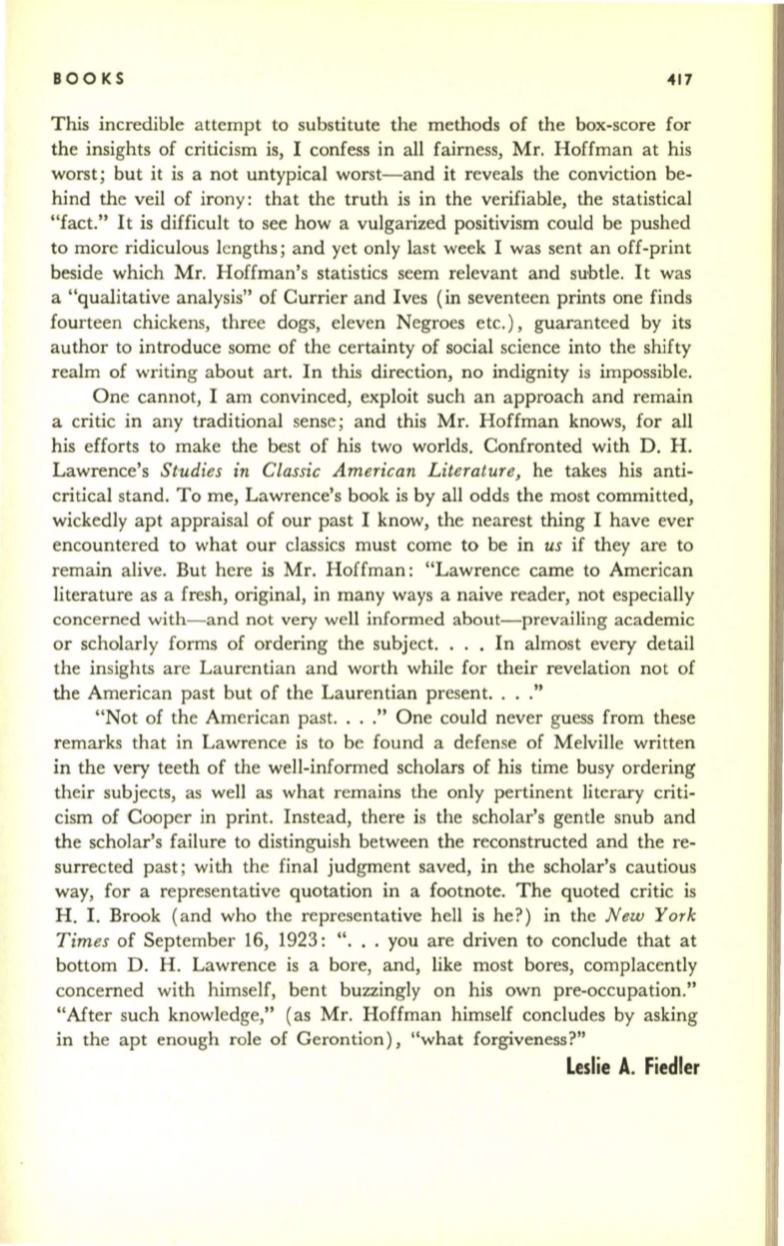
BOOKS
417
This incredible attempt to substitute the methods of the box-score for
the insights of criticism is, I confess in all fairness, Mr. Hoffman at his
worst; but it is a not untypical worst-and it reveals the conviction be–
hind the veil of irony: that the truth is in the verifiable, the statistical
"fact." It is difficult to see how a vulgarized positivism could be pushed
to more ridiculous lengths; and yet only last week I was sent an off-print
beside which Mr. Hoffman's statistics seem relevant and subtle.
It
was
a "qualitative analysis" of Currier and Ives (in seventeen prints one finds
fourteen chickens, three dogs, eleven Negroes etc.), guaranteed by its
author to introduce some of the certainty of social science into the shifty
realm of writing about art.
In
this direction, no indignity is impossible.
One cannot, I am convinced, exploit such an approach and remain
a critic in any traditional sense; and this Mr. Hoffman knows, for all
his efforts to make the best of his two worlds. Confronted with D. H.
Lawrence's
Studies in Classic American Literature,
he takes his anti–
critical stand. To me, Lawrence's book is by all odds the most committed,
wickedly apt appraisal of our past I know, the nearest thing I have ever
encountered to what our classics must come to be in
us
if they are to
remain alive. But here is Mr. Hoffman: "Lawrence came to American
literature as a fresh, original, in many ways a naive reader, not especially
concerned with-and not very well informed about-prevailing academic
or scholarly forms of ordering the subject. . . .
In
almost every detail
the insights are Laurentian and worth while for their revelation not of
the American past but of the Laurentian present. .. ."
"Not of the American past...." One could never guess from these
remarks that in Lawrence is to be found a defense of Melville written
in the very teeth of the well-informed scholars of his time busy ordering
their subjects, as well as what remains the only pertinent literary criti–
cism of Cooper in print. Instead, there is the scholar's gentle snub and
the scholar's failure to distinguish between the reconstructed and the re–
surrected past; with the final judgment saved, in the scholar's cautious
way, for a representative quotation in a footnote. The quoted critic is
H.
I.
Brook (and who the representative hell is he?) in the
New York
Times
of September 16, 1923: " . .. you are driven to conclude that at
bottom D. H. Lawrence is a bore, and, like most bores, complacently
concerned with himself, bent buzzingly on his own pre-occupation."
"After such knowledge," (as Mr. Hoffman himself concludes by asking
in the apt enough role of Gerontion), "what forgiveness?"
Leslie A. Fiedler


